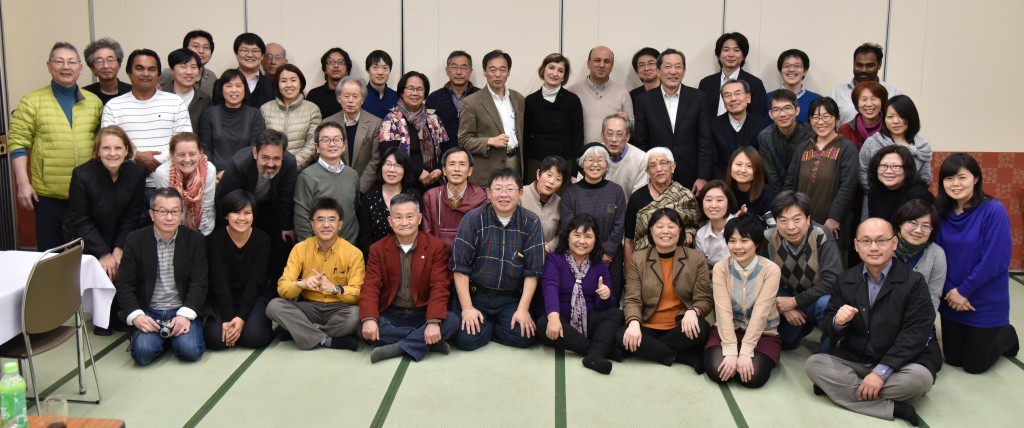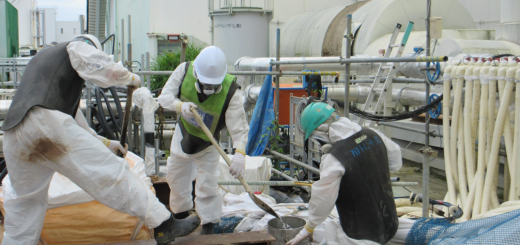Report on 17th No Nukes Asia Forum (NIT No. 171)
 From March 22 through March 24, the No Nukes Asia Forum (NNAF) was held in Iwaki, Fukushima Prefecture. About 30 people from India, Philippines, Turkey, Korea, Hong Kong and Taiwan as well as about 40 people from Japan, many from the Fukushima area, attended the forum. One of the main themes for this year’s forum, five years after the Fukushima Daiichi disaster, was for the Asian participants to come to Fukushima and see with their own eyes and listen with their own ears to the devastation it has caused to people’s lives, communities and the natural environment. The participants were able to experience directly, not only the destruction and despair, but also the strength and the resilience as well as the strategies and the differences in the reactions of the people of Fukushima to this ongoing catastrophe.
From March 22 through March 24, the No Nukes Asia Forum (NNAF) was held in Iwaki, Fukushima Prefecture. About 30 people from India, Philippines, Turkey, Korea, Hong Kong and Taiwan as well as about 40 people from Japan, many from the Fukushima area, attended the forum. One of the main themes for this year’s forum, five years after the Fukushima Daiichi disaster, was for the Asian participants to come to Fukushima and see with their own eyes and listen with their own ears to the devastation it has caused to people’s lives, communities and the natural environment. The participants were able to experience directly, not only the destruction and despair, but also the strength and the resilience as well as the strategies and the differences in the reactions of the people of Fukushima to this ongoing catastrophe.
The Forum opened on the morning of March 23 with presentations from each country on their respective situations regarding nuclear policy and their movements and actions. A Member of Parliament from Taiwan explained that the new government, elected in January this year, had promised that Taiwan would be nuclear free by 2025. We heard about the long struggle that the anti-nuclear movement had waged, including the tactic of trying to force a national referendum to stop construction on Taiwan’s fourth nuclear power plant (NPP). Although the government did not allow the referendum to go ahead, construction was indeed halted. Taiwan has great potential for renewable energy and the movement has also made strong efforts to focus on how citizens and communities can generate their own energy through solar and other renewables. Wind energy is particularly plentiful in Taiwan.
The news from other countries was not so bright. Activists from Korea managed to hold referendums in two towns, Young-Duk and Sam-Cheok, which are slated as sites for new NPPs. Although the vote indicated that the local people are strongly opposed to the NPPs, the government may well ignore the referendum results. While the Philippines remains nuclear free since the closure of the Bataan NPP in 1986, the government talks of reviving it and indeed has identified 13 other possible NPP sites. The participants from the Philippines vowed to continue their fight until the government has ruled out the nuclear option altogether. We also heard, from the Hong Kong participant, about the Chinese government’s rapidly expanding nuclear construction and the disturbing lack of any information regarding anything to do with NPPs or nuclear policy, as well as the absence of an effective civil society in China.
India and Turkey are two countries that Japan is seriously considering exporting nuclear technologies to, but we heard about the extremely strong opposition to these exports in both countries as well as the lax safety standards and the total lack of transparency. One of the Indian participants asked how the Japanese government could even consider exporting nuclear technology considering the devastation it was still causing its own people. She also emphasized the connection between nuclear power and nuclear weapons, again questioning how Japan, the only country that has experienced the horrors of atomic bombs, could be recognizing India’s nuclear weapon status and effectively assisting its weapons program by nuclear plant exports, even if they were in the name of peace.
Many of the participants in this NNAF were participating for the first time, and all very much appreciated learning about the situation in other countries in their region. Many felt a need to keep up this communication as there are many similarities regarding the situation in each country and being aware of this could help and support each of the national movements. The international nuclear lobby is operating on a global level, so to fight it we must join together, especially in the Asian region, which is the fastest growing nuclear market.
Voices from Fukushima
After lunch we heard from several people from the Fukushima area. Kazuyoshi Sato, who was a member of the Iwaki City Council for three terms, including when Fukushima Daiichi exploded, and has been involved in the anti-nuclear movement in various capacities for 28 years, gave us a detailed description of how events have unfolded since March 2011, and how right from the construction of Fukushima Daiichi, there have been structural problems which contributed to the accident and meltdown. These problems have been pointed out many times, but Tokyo Electric Power Company (TEPCO) preferred to ignore them rather than spend the large sums required to fix them. Mr. Sato also gave us information on the government policy of lifting the evacuation orders for many of the areas close to the Daiichi NPP. Last September the order was lifted for Naraha Town and next March the government plans to lift the evacuation orders for Tomioka and Iitate, claiming that these areas have been decontaminated and are now safe to return to. However radiation readings confirm that there are many hotspots still remaining and Mr. Sato believes that the government is more motivated by making everything look safe and problem-free before Tokyo hosts the 2020 Olympics than by any true concern for the safety of the people. Once the orders are lifted, even people who do not want to move back to their old homes will no longer be eligible for compensation, putting further pressure on their already difficult lives.
The next speaker was Ruiko Muto, a famous activist from Fukushima, who is a leader of Hidanren, the Federation of Nuclear Accident Victims’ Organizations. She is fighting for justice for victims like herself on a number of fronts, including in the courts, as well as providing support for patients in hospitals. She pointed out that 166 people, many of them children, have been diagnosed with thyroid cancer, but patient support groups are often centered around hospitals, and do not include the families of patients. Ms. Muto also pointed out the very important battle that is taking place on the information front. As an example she mentioned a pamphlet produced by the Ministry of Environment which is now being distributed free to the public. In this pamphlet there is an explanation of how radiation damages DNA. At a level of 1mSv, each cell may be damaged once, but, the pamphlet claims, this usually corrects itself in a few hours, so we don’t have to worry. It mentions more vaguely that sometimes the cells don’t correct themselves, but does not go into the implications of what this really means. Ms. Muto emphasized that these official publications, which are 90% true but 10% misleading, are very difficult to counter and we must all be wary of this and come up with ways to counter propaganda.
After Ms. Muto, three more women from different parts of Fukushima told us how the accident had affected their lives and the actions they were taking to try to remain safe and to end nuclear power. Masumi Kowata, originally from Ohkuma Town and now evacuated to Aizu-Wakamatsu, also in Fukushima Prefecture, is an Ohkuma Town councilor. She proudly told us that she got the second highest number of votes in the election, showing there was significant popular support for an anti-nuke candidate, but within the Council she feels pressured to agree to what she considers outrageous plans such as turning Ohkuma Town, right next to Fukushima Daiichi NPP, into a strawberry producing region. Keiko Sasaki, a former junior high school teacher from Fukushima City, also mentioned the propaganda battle and her efforts to ensure that the Prefectural Environment Creation Center portrays the nuclear disaster and its effects accurately instead of glossing over inconvenient truths. Aki Hashimoto told us of her dilemmas and feelings of guilt in not evacuating her grandson until six months after the accident. He now lives in Fukuoka, Kyushu with his mother (her daughter), but his father moved back to Fukushima and his parents are now divorced.
The destruction of families and the deep effects on people’s lives caused by the nuclear disaster became very real for all the participants after listening to these voices. The following day, we went to Tomioka which is still a ghost-town Decontamination workers were the only sign of human life, a petrol pump the only business that was operating. Streets of empty houses, still with damage from the tsunami, and more recently from wild animals, really brought home what this disaster has done to the lives of so many people who used to live there.
As part of our fieldwork we also went to the Iwaki Radiation Measuring Center, a fully equipped center which can measure both beta and gamma rays from any produce that citizens bring to be tested, as well as do full body radiation counts and test for thyroid abnormalities. This center is an NPO and has been set up and run totally by citizen donations. The machines are state-of-the-art technology, and the large sums necessary to purchase them were raised by ordinary citizens because they did not trust government information. All of the NNAF participants were very impressed by this facility.
The participants from six Asian countries went home with a feeling of anger and sadness after listening to the voices of Fukushima, but also with a feeling of inspiration to see what the strength of those affected has achieved and a new resolve to keep fighting against nuclear power in their own countries and to share the realities they had experienced.
(Text by Caitlin Stronell, CNIC)


